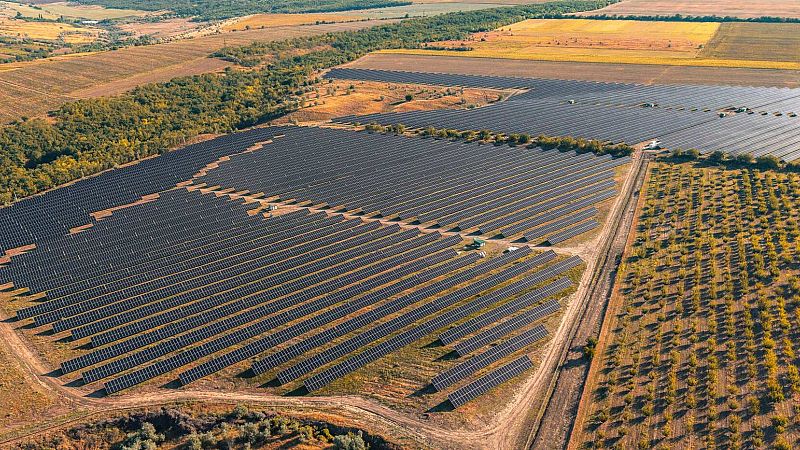
When the US government shut down two weeks ago, so did parts of its climate agenda.
Thousands of federal workers have been sent home, billions in clean energy grants frozen and the country’s largest planned solar farm wiped from the government’s books.
Analysts say the shutdown marks a slowdown in the nation’s already uncertain climate progress, but it also serves as a reminder that the world’s path to net zero can easily hinge on political whims – or even something as mundane as passing a budget.
A mega-solar project disappears
The Esmeralda 7, a collection of seven solar farms to be built on more than 25,000 hectares of federal land in the Nevada desert, was expected to generate up to 6.2 gigawatts of power, enough to supply two million homes.
Under the Biden administration, it had become a symbol of the country’s ambition to modernise its energy mix amid rising demand from AI firms and fast-growing cities.
But last week, after the federal government shut down, the US Bureau of Land Management (BLM) quietly changed the project’s status from “pending” to “cancelled” on its permitting website.
The Interior Department denied Esmeralda 7 was cancelled. Instead, its spokespeople explained that contractors could re-bid for individual parts of the project.
“During routine discussions prior to the lapse in appropriations, the proponents and BLM agreed to change their approach for the Esmeralda 7 Solar Project in Nevada,” an Interior Department spokesperson said in a statement.
“The applicants will now have the option to submit individual project proposals to the BLM to more effectively analyse potential impacts.”
The cancellation has drawn increasingly rare criticism from across the aisle in American politics. Nevada’s Democratic senators warned the decision would harm jobs and investment, while Utah’s Republican governor Spencer Cox said it would be “how [the US loses] the AI-energy arms race with China.”
Environmentalists were divided.
Some argued that the solar installations would threaten habitats for species such as the desert tortoise and Joshua tree, as well as sacred Indigenous sites. But most agreed the reversal creates uncertainty when stability is vital for long-term climate goals.
Billions in climate funds frozen
The Esmeralda project wasn’t the only casualty.
On the same day the shutdown began, the US Energy Department cut nearly €7 billion in grants and awards for hundreds of green energy and infrastructure projects – all in states that voted for the Democrat party in the previous presidential election.
The cuts include up to €1 billion for a facility in California that works on hydrogen technology and about €860 million for a hydrogen project in the northwest.
Other cancelled funding affects projects aimed at reducing carbon emissions, strengthening electrical grids and modernising public transport, all crucial to meeting climate goals.
The funding freeze could also have a ripple effect following the passing of Donald Trump’s signature “One Big Beautiful Bill” Act in July.
Analysts at Energy Innovation, a San Francisco-based think tank, warns that removing clean energy tax credits could increase American household energy bills over the next decade and slow progress toward net zero emissions.
They also say that the US could lose out on billions in planned investment and hundreds of thousands of jobs, as renewable energy manufacturing companies that benefited from tax incentives look overseas for other, more stable places to build.
Pollution rises when oversight stops
Beyond cancelled projects and stalled funding, shutdowns have another, less obvious consequence: more pollution.
A recent study published by researchers at Penn State University found that during the 2018-2019 US government shutdown, coal-fired power plants emitted more fine particulate matter – microscopic particles that have been linked to heart and lung disease, as well as premature deaths – when federal inspections were paused.
With Environmental Protection Agency (EPA) staff furloughed, power plants temporarily relaxed their pollution controls, the researchers revealed.
The findings underscore how essential environmental oversight is, and how quickly progress can backslide when that oversight disappears.
“Even short-lived increases in particulate matter have the potential to worsen public health outcomes,” said Ruohao Zhang, lead author of the study.
“Stable enforcement and continuous monitoring are useful tools for ensuring compliance, reducing emissions and protecting health.”
The shutdown exposes a fragile climate architecture
The US environmental enforcement system depends on continuity. But during a funding lapse, the EPA must suspend most monitoring, permitting and enforcement actions.
Only employees whose work is considered essential to “protect human life or property” are allowed to continue working. According to the EPA’s internal contingency plan, that amounts to only 11 per cent of its 15,000 employees.
Each interruption widens the “enforcement gap,” as inspections are postponed, backlogs grow and some violations go unpunished.
While climate change is a long-term issue, the mechanisms to fight it operate on short-term political timelines, and every lapse can compound the problems the world faces.
“Interruptions in inspections and enforcement have the potential to trigger immediate environmental and health consequences,” said Zhang.
Until recently, the EPA had been using carryover funds to keep its staff on the job. At the end of last week – 10 days into the shutdown – the agency began sending furlough notices to workers. Tim Whitehouse, executive director at Public Employees for Environmental Responsibility, called the EPA layoffs “illegal and morally corrupt.”
The warning goes beyond Washington
The implications for climate goals extend far beyond the United States.
As the world’s second-largest emitter after China, US climate policy influences global markets, investment and momentum for change.
In January, the US withdrew its international climate finance plan. Earlier this year, MIT researchers reported the Trump administration had also terminated National Science Foundation grants for more than 100 research projects related to climate change.
With the shutdown in effect, many more green tech projects, collaborative initiatives and research goals that rely on federal funding are on pause.
For allies in Europe and elsewhere, it sends a troubling message that even previously funded climate projects are only as stable as the political system behind them.
As congressional chambers sit empty in Washington, the question remains: how can a country decarbonise when its government can’t stay open?







